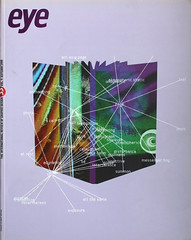Autumn 1999
Editorial Eye 33
The first editorial by Eye’s new editor
After a turbulent decade for graphic design, it is now clear that the raw stuff of communication is code. From classical music to blockbuster movies and from billboard posters to the pages of this magazine, everything can be manipulated, transported and stored in the digital domain. The file on your hard disk could be sound, image, text or film clip – to the computer it is immaterial.
But materiality is what we crave to make culture interesting. We might make a living in front of the computer screen, but it is not a life. The sensual enjoyment of books and albums lies not only in their content, but in the pleasure they yield as three-dimensional objects in our hands, as experiences. The smell of ink, the texture of heavy board, the smoothness of fine paper – these affect the way we encounter, remember and re-discover our favourite things.
Sound and motion, the twin themes of this issue of Eye, are changing designers’ priorities. And as onscreen work enters a period of redefinition, so does design for print: we are seeing a renaissance in tactile packaging for books and music of all kinds. Even electronic products – computers, consoles, phones – are becoming soft and touchable, personal accessories rather than hard technology.
So typography can play it cool for a while. Type that once blurred, stretched and strained to escape the page has the screen for a playground, where it can whirl tirelessly for websites and videos. And movement – however crude – implies or demands a sound, something that provides feedback and a sense of reality for the user. The pioneers of silent film soon realised that sound was essential for moving pictures. Decades had to elapse before that particular technology-driven industry came of age: perhaps multimedia design is experiencing similar growing pains. Meanwhile, the power of print lies in its stillness, a point made by Michael Worthington in his thoughtful essay about moving and static type.
Graphic designers have a privileged position within the nexus of contemporary culture, dealing with art, commerce and science in print, on screen and in the public realm. It’s a role that carries responsibility, as the updated ‘First Things First 2000’ manifesto reminds us. If designers are the best people to pull the different strands together, they must have a broader, more interdisciplinary sensibility, while staying true to the skills and enthusiasms that made them become designers in the first place. The computer’s ubiquity means that many of the processes involved appear similar. But in the end, there are crucial differences: between movement and stillness, screen and print, sound and vision, good and bad, and we ignore these at our peril. JLW
First published in Eye no. 33 vol. 9, 1999
Eye is the world’s most beautiful and collectable graphic design journal, published quarterly for professional designers, students and anyone interested in critical, informed writing about graphic design and visual culture. It is available from all good design bookshops and online at the Eye shop, where you can buy subscriptions and single issues.

